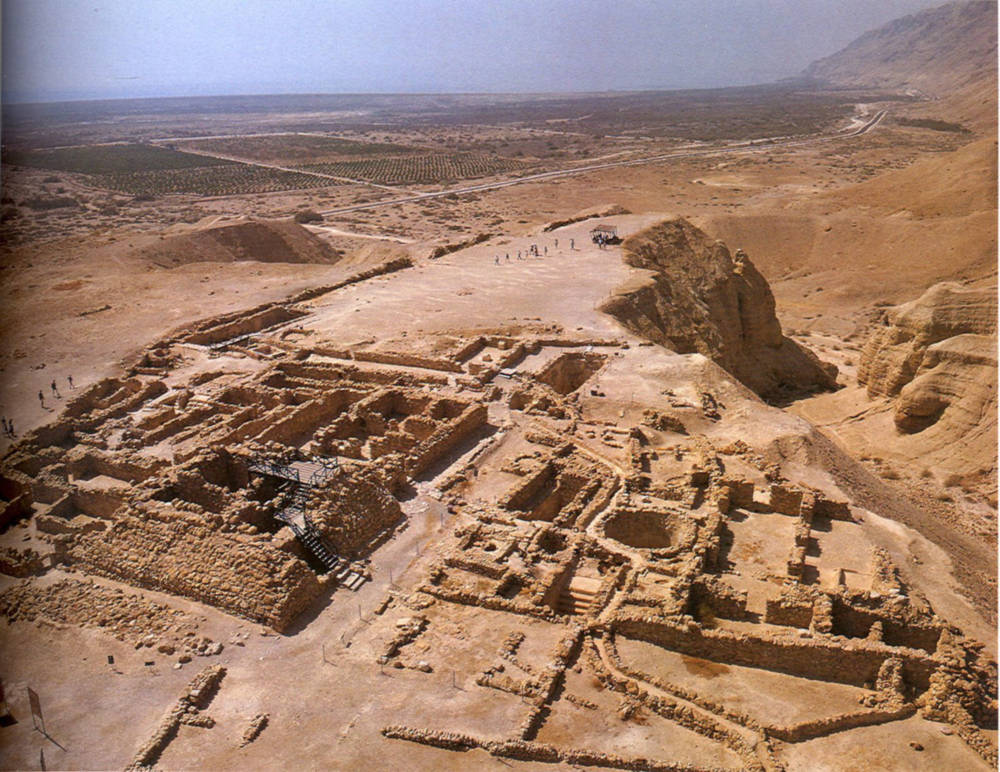 Khirbet (=ruins of) Qumran
Khirbet (=ruins of) Qumran
Since the discovery of the first Dead Sea Scroll (DSS) manuscripts in the caves of Qumran in 1946, Biblical “scholars” and “theologians” have opined about who actually penned them and why. For the most part, their theories are inconclusive at best. Is it because they know the truth and have been providing mis-/disinformation about it?
The mystery is easily solved in the Book of Acts. Luke and Acts were written to Mattathias ben Theophilus (recorded simply as “Theophilus” — just as Yosef ben Caiaphas was referenced as “Caiaphas” in the New Testament). Theophilus was the kohen gadol (=chief priest) of the Second Temple in 65-66 CE before the outset of the First Jewish-Roman War spanning 66-74 CE. Luke was explicitly written in chronological order taken from eyewitness accounts; see Luke 1:1-4 concentrating on v3. The purpose was to give Israel one last chance to acknowledge her Messiah (Heb. Mashiach) or suffer the consequences of denying the Son of God.
The “sect” was called THE WAY (Heb. HaDerech/Gr. tēn Hodon) in Acts and throughout various DSS manuscripts. Josephus, a self-described Pharisee (cf. Section 2) — and we know what Christ thought of them in The Eight Woes recorded in Matthew 23, coined the derogatory term “Essenes” (=pious ones) that is applied incorrectly to this day. Somehow, NO “scholar” nor “theologian” has made the very obvious connection between The Way in Acts and the DSS to the Essenes of Josephus; that is because they know that this was the ONE, TRUE CHURCH — “to the Jew first and also to the Greek” (Romans 1:16, 2:9-11). To admit this would send reverberations to the core of modern “Christianity” and “Judaism” and would challenge the alleged “apostolic authority” that some churches falsely claim. When was the last time you heard the “sect” called The Way mentioned in your church or synagogue?
Regardless, this is what he recorded about them in Antiquities of the Jews, Book 18, Chapter 1, Section 5:
Ant. 18.1.5 “The doctrine of the Essens is this: That all things are best ascribed to God. They teach the immortality of souls, and esteem that the rewards of righteousness are to be earnestly striven for; and when they send what they have dedicated to God into the temple, they do not offer sacrifices because they have more pure lustrations of their own; on which account they are excluded from the common court of the temple, but offer their sacrifices themselves; yet is their course of life better than that of other men; and they entirely addict themselves to husbandry. It also deserves our admiration, how much they exceed all other men that addict themselves to virtue, and this in righteousness; and indeed to such a degree, that as it hath never appeared among any other men, neither Greeks nor barbarians, no, not for a little time, so hath it endured a long while among them. This is demonstrated by that institution of theirs, which will not suffer any thing to hinder them from having all things in common; so that a rich man enjoys no more of his own wealth than he who hath nothing at all. There are about four thousand men that live in this way, and neither marry wives, nor are desirous to keep servants; as thinking the latter tempts men to be unjust, and the former gives the handle to domestic quarrels; but as they live by themselves, they minister one to another. They also appoint certain stewards to receive the incomes of their revenues, and of the fruits of the ground; such as are good men and priests, who are to get their corn and their food ready for them. They none of them differ from others of the Essens in their way of living, but do the most resemble those Dacae who are called Polistae [dwellers in cities].”
These “Essenes” — who were chaste priests, Levites, Israelites, and proselytes lived a communal lifestyle with all things in common — were considered to be “wise men” as they were known for their gift of prophecy. The following is found in Ant. 13.11.2:
Ant. 13.11.2 “But here one may take occasion to wonder at one Judas, who was of the sect of the Essens, and who never missed the truth in his predictions; for this man, when he saw Antigonus passing by the temple, cried out to his companions and friends, who abode with him as his scholars, in order to learn the art of foretelling things to come? That it was good for him to die now, since he had spoken falsely about Antigonus, who is still alive, and I see him passing by, although he had foretold he should die at the place called Strato’s Tower that very day, while yet the place is six hundred furlongs off, where he had foretold he should be slain; and still this day is a great part of it already past, so that he was in danger of proving a false prophet. As he was saying this, and that in a melancholy mood, the news came that Antigonus was slain in a place under ground, which itself was called also Strato’s Tower, or of the same name with that Cesarea which is seated at the sea. This event put the prophet into a great disorder.”
These “wise men (Gr. magos from Matthew 2:1) from the east” of Jerusalem — 15 miles as the crow flies — in the desert wilderness of Qumran had resided there for nearly two centuries before Christ’s conception on the Feast of New Oil (Heb. Chag Yitzhar) in 5 CE and His birth on the Feast of Weeks (Heb. Chag Shavu’ot) in 6 CE during the census of Quirinius; see Luke 2:2. (And, yes, I have confirmed what the “star of Bet Lechem” was with our local planetarium.) What is not widely publicized about the DSS is that these “wise men” were also greatly attuned to the signs in the Heavens (Genesis 1:14-19 concentrating on v14) including the course of the Heavenly luminaries (i.e., the sun and moon), lunar cycles, zodiology (=annual traversal through the zodiac), and even brontology (=signs from thunder).
Yochanan (John), who was a Levite, went to study at Qumran; see Luke 1:80. Recall that he was “the voice crying out in the (desert) wilderness” and had his own disciples (Matthew 9:14 et al.). The Feast of Weeks is when The Way renewed Biblical covenants. Yehoshu’a (=Joshua, falsely called “Jesus” from the Latin transliteration — NOT translation — of His name) ushered in the ultimate New Covenant with His birth. The manuscript that documented their way of life is in the Community Rule (Heb. Serekh* HaYahad) designated as 1QS.
Author’s Note: Serekh (samech-resh-kaph) does not mean “rule” as so many DSS scholars have proclaimed and mindlessly regurgitated. According to Reuben Alcalay’s “The Complete Hebrew/English Dictionary (Nun-Tav)” on p.1823 under the second entry, serekh means “custom, manner, or conduct.” Therefore, the better translation is “Community Conduct” or “Conduct of the Community” instead of “Community Rule.” What is interesting is that the first entry is defined as “dragging” in reference to adherence. We know from Biblical history that the Israelites were notorious for disobeying the Law of Moses. Picture this: The Conduct of the Community would ensure adherence — to drag one back into compliance with the Law — or the transgressor would be punished or banished if the infraction were severe enough.
Malachi was likely the Teacher of Righteousness, and John Hyrcanus — the first Jewish ruler to “proselytize by the sword,” loot David’s tomb (at least twice!), and embrace Hellenistic Judaism among other detestable things for political influence — was the Wicked Priest recorded in the DSS when this “sect” was in its infancy. Malachi explicitly speaks of The Way and of the coming of Yochanan before Yehoshu’a:
Malachi 2:8 But as for you, you have turned aside from THE WAY [emphasis mine]; you have caused many to stumble by the instruction; you have corrupted the covenant of Levi,” says the Lord of hosts. (NASB 1995)
Malachi 3:1 “Behold, I am going to send My messenger, and he will clear THE WAY [emphasis mine] before Me. And the Lord, whom you seek, will suddenly come to His temple; and the messenger of the covenant, in whom you delight, behold, He is coming,” says the Lord of hosts. (NASB 1995)
The original prophesy in Isaiah:
Isaiah 40:3 A voice is calling,
“Clear THE WAY [emphasis mine] for the Lord in the wilderness;
Make smooth in the desert a highway for our God. (NASB 1995)
Here is the confirmation to this prophesy from the three Synoptic Gospels and John focusing on Matthew 3:3, Mark 1:3, Luke 3:4, and John 1:23. No one knows with absolutely certainty when the Book of Malachi was originally penned; therefore, it could have been during the second century BCE when The Way was formed. In fact, Malachi may not be a proper name but a title meaning “My Messenger” in reference to the Angel of the Lord. Multiple sectarian manuscripts of the DSS clearly state that literal angels were in the presence of those worshipping within the Community.
The Congregation, or men and women of The Way, lived in Damascus, Syria, where there is a “street called Straight” to this very day; see Acts 9:11. Their way of life was recorded in the Damascus Document. They would dedicate their first-born sons to Yahoah and send them to Qumran to study. Where was Sha’ul (Saul) going to persecute the men and women of The Way under direct orders (i.e., letters) from the Great Sanhedrin? See Acts 9:1-22, 22:1-16. It’s all right there in black and white, folks! You just have to open your eyes and quit listening to Biblical “scholars” and their false machinations.
Of those in Qumran, the last vestiges of them were discovered at Masada according to research via the Biblical Archaeology Society (BAS). Scribal remnants were crossed matched at both locations.
So, how does The Way factor into prophesy? They are the 144,000 of Revelation! What other Jewish males in that number (12,000 from each of the 12 tribes of Israel) were chaste? Neither the Pharisees nor Sadducees were celibate; Josephus recorded it in Ant. 18.1.5. Certain DSS documents clearly state that those in Qumran were. This “sect” separated themselves from the political and religious corruption being practiced in Jerusalem, and they lasted for just under three centuries (early second century BCE to 74 CE). The generation that existed in the time of Christ’s crucifixion and resurrection in 36 CE certainly witnessed the destruction of the Second Temple in 70 CE. They met their ultimate demise in 74 CE at Masada. But, believers in Christ will encounter them again as the 144,000…
Be sure to read the companion articles in the HaDerech (The Way) series:
- HaDerech: Evidence of THE WAY in Acts
- HaDerech: It’s About Time
- The Greatest Discovery of the Dead Sea Scrolls
Shema Yisrael! (Hear, Israel!)
Copyright (C) 1995-2018, L. Alan Schuetz. All rights reserved.
2 Timothy 2:15 Be diligent to present yourself approved to God as a workman who does not need to be ashamed, accurately handling the word of truth. (NASB 1995)


Interesting.
LikeLike
Folks, this is why the DSS manuscripts are so important; the Aleppo Codex was written in the 10th century CE with the Leningrad Codex in 1008-9 CE. As this article states, the authors added to the Word via nekkudot, te’amim, and masora; the Scriptures specifically warn against that! The Septuagint (LXX) is more reliable than these codices as they were translated between the 3rd and 2nd centuries BCE.
LikeLike
Referencing this article: https://unmaskingantijehovahpeople.wordpress.com/2018/11/27/a-book-to-trust-23/. Reuben Alcalay, a famous Hebrew lexicographer, explicitly did not use vowel points for a similar reason.
LikeLike